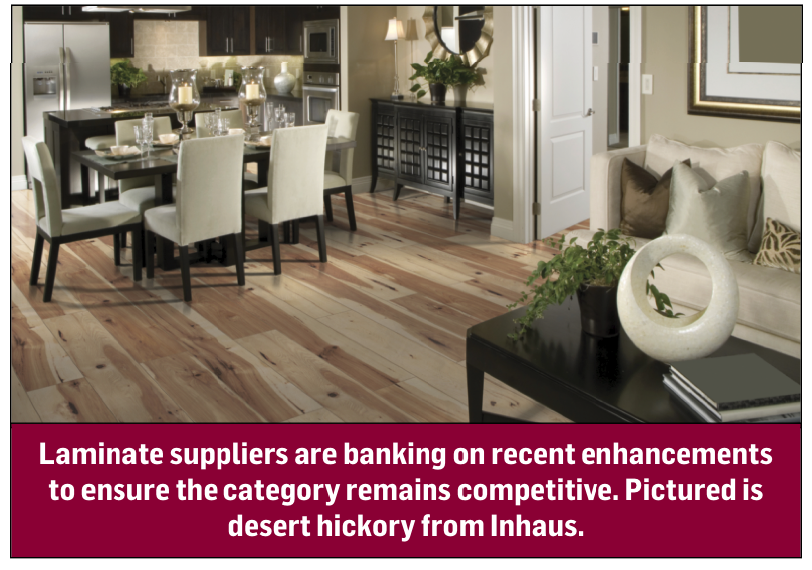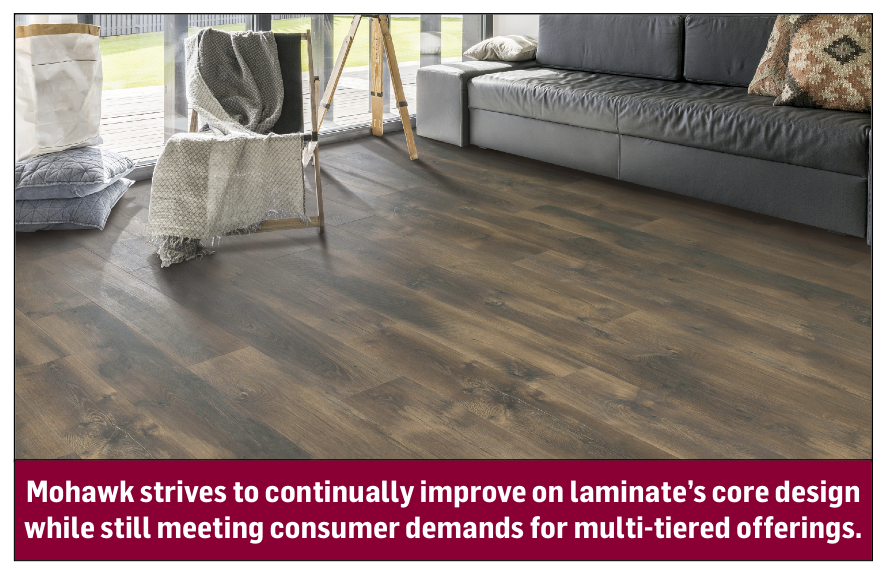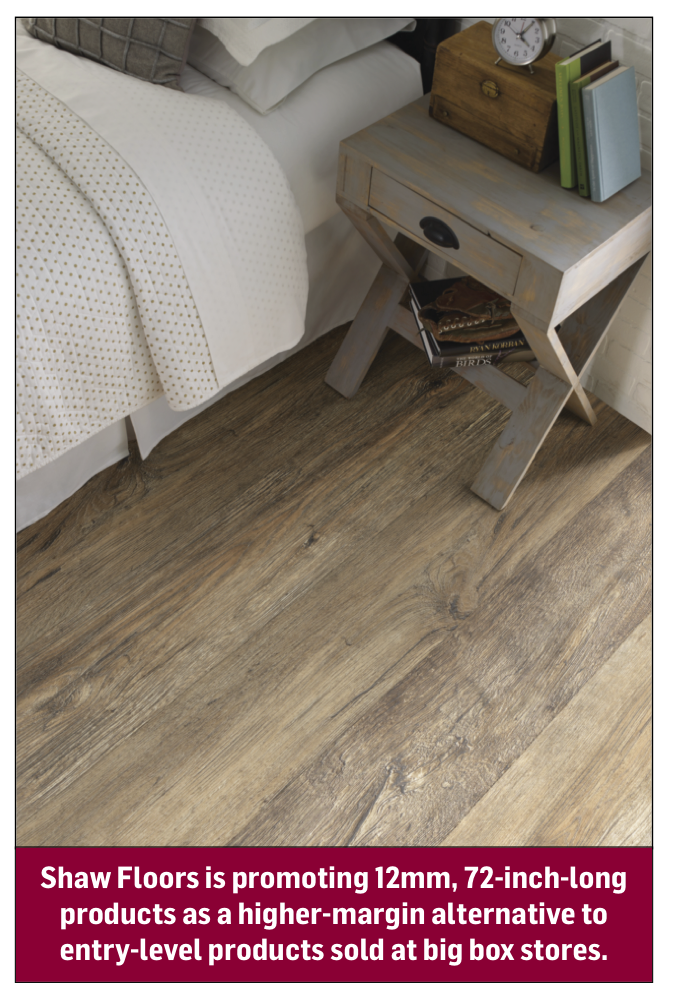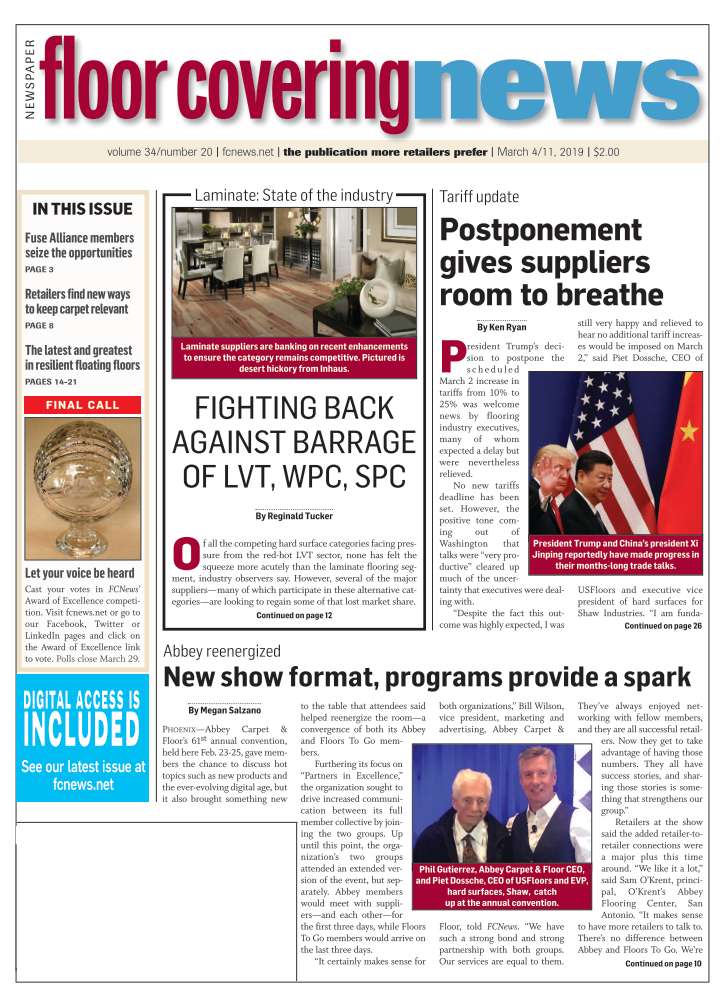March 4/11, 2019: Volume 34, Issue 20
By Reginald Tucker
 Of all the competing hard surface categories facing pressure from the red-hot LVT sector, none has felt the squeeze more acutely than the laminate flooring segment, industry observers say. However, several of the major suppliers—many of which participate in these alternative categories—are looking to regain some of that lost market share.
Of all the competing hard surface categories facing pressure from the red-hot LVT sector, none has felt the squeeze more acutely than the laminate flooring segment, industry observers say. However, several of the major suppliers—many of which participate in these alternative categories—are looking to regain some of that lost market share.
For many laminate suppliers, priority No. 1 is recouping some of the showroom space lost to LVT, WPC and SPC over the years. “During laminates’ heyday—we’re talking about the run the category had between 1996 and 2003-04—the average retailer had five-plus laminate displays on the showroom floor,” said Drew Hash, vice president, hard surface product/category management, Shaw Floors. “Now you’re lucky to see one laminate display on the show floor.”
Ask anyone who hasn’t been asleep at the wheel for the past five to six years, and they will tell you the popularity of LVT is the primary reason for laminates’ loss of share. “Without a doubt, competition from WPC/LVT/SPC is the biggest challenge facing the laminate flooring category today,” said Dan Natkin, vice president, hardwood and laminate, Mannington. “These categories have grown tremendously in the past 10 years and have presented some headwinds for the category.”
Natkin is not alone. Keith Wiethe, director of sales for Home Legend, which participates in several hard surface categories, concurs. “Over the past couple of years there has been a definite reduction in showroom space for laminate. There is a perceived value that WPC/SPC products are a better option.”
Therein lies the main challenge, suppliers say—convincing retail sales associates that it’s not only worth taking another look at the category but that it can also be beneficial to devote more square footage to the category.
“With recent technological enhancements in the laminate category, this product now has its own water-resistance properties,” Wiethe said, referring to what is arguably the biggest selling point of the WPC/SPC-type products that have challenged laminates so fiercely in recent years.
Reading the writing on the wall, several companies that produce laminate flooring saw the increased competition from the likes of WPC and SPC as an opportunity to invest in the category. Such was the case with Mohawk, which—via the launch of RevWood—sought to not only vastly improve the product’s performance and aesthetic characteristics but also attempt to redefine the category in the process.
Jeff Juzaitis, vice president, product management, Mohawk, cited the combination of advanced Uniclic locking technology, edge sealers and coreboard construction that work in tandem to create what he called a “waterproof matrix” that doesn’t allow moisture to permeate the product.
“With RevWood, consumers have the expectation that they can live on it, spill a glass on the floor or walk in from the outside with wet feet and not have any of the problems associated with laminates in the past,” he told FCNews. “This has made the entire category see a resurgence especially in the specialty retail space.”
Other major suppliers of laminate flooring point to their own innovations in the area of water resistance—advancements that have already reaped benefits. “For the last five years, CFL has been focusing on water-resistant laminate with special features, benefits and designs, and it has been doing well year over year,” said Barron Frith, president, CFL, North America, citing the company’s popular Atroguard line.
A thin line
As more laminate manufacturers look to leverage the category’s improvements in the area of resistance to water incursion and moisture, the chorus of respective product claims has grown ever louder. On one side of the coin you have those who tout their products as “waterproof” vs. others who say their laminate floors are “water resistant.”
But that begs the question: Is this a good thing for the laminate category, which, historically, faced some criticism for overblown claims during the height of the product’s popularity back in the mid- to late 1990s? Supplier views remain mixed on this particular issue.
“We don’t see any worry in calling our products waterproof once they’ve been installed correctly on the floor,” Mohawk’s Juzaitis explained.
CFL’s Frith, in speaking for his own company, attested to the advancements made in this regard. “Water-resistant laminate is far from new for CFL. The ‘bulletproof’ reputation has proven to be a huge positive for us since we launched Atroguard five years ago. It combines the strengths of laminate with the water resistance features of all  the vinyl categories recently growing in popularity.”
the vinyl categories recently growing in popularity.”
Mannington’s Natkin, who also serves as the president of the North American Laminate Flooring Association (NALFA), said this kind of marketing is helpful. “The category is already more indentation and scratch resistant than virtually any other flooring type, so the renewed innovation is definitely a positive step,” he said.
Other industry executives, however, strike a more cautious tone. “I can only speak to this issue from Shaw Floors’ perspective, and within our company we have a very robust protocol when it comes to product testing,” Hash explained. “We feel it made the most sense to utilize the ‘water-resistant’ verbiage when promoting our products. What others want to do is their prerogative.”
Then there are those like Derek Welbourn, CEO of Inhaus, who views the matter as a double-edged sword. “We enjoy the additional focus brought to the laminate category by these water-resistant—or, in some cases, waterproof—claims. However, we view any statements that oversell a product’s attributes as ultimately harmful to the business. The truth is that laminate—although water resistant and in some cases highly water resistant—is not waterproof. Laminate is based on a fiberboard core and will ultimately fail if soaked with water over time.”
Travis Bass, executive vice president of sales and marketing for Swiss Krono, also warns against the temptation to oversell the product. “Responsible moisture-resistant marketing will help; touting the product as moisture proof may be harmful,” he noted.
Home Legend’s Wiethe embraces a similar philosophy. “Anytime you oversell a product, the experience by the end user may not be favorable,” he told FCNews. “Proper expectations should be set especially in today’s environment where consumers are more intelligent about products due to the information that is easily accessible to them.”
Pressure from within
Threats from competing categories is not the only major challenge facing the laminate sector. Industry observers also point to issues taking place within the product category itself—namely cannibalization by lower-end products. For many suppliers it represents a two-fold battle: competing against entry-level laminates within the category while still challenging the likes of WPC and SPC products—all of which continue to evolve at a rapid pace.
 For companies like Shaw Floors, the greatest opportunity lies in step-up products. “Sales of our better-end, moisture-resistant products—which we classify as Repel—are doing very well in the market,” Hash explained. “Where we have had more challenges within the laminate category, quite frankly, is on the entry-level side where there’s more pressure from inexpensive 7mm-8mm products vs. the higher quality 12mm option, which accounts for a much smaller piece of the pie.”
For companies like Shaw Floors, the greatest opportunity lies in step-up products. “Sales of our better-end, moisture-resistant products—which we classify as Repel—are doing very well in the market,” Hash explained. “Where we have had more challenges within the laminate category, quite frankly, is on the entry-level side where there’s more pressure from inexpensive 7mm-8mm products vs. the higher quality 12mm option, which accounts for a much smaller piece of the pie.”
The goal, according to suppliers like Shaw Floors, is to put more “distance” between the types of laminate products primarily sold at home centers vs. the more differentiated, higher-margin goods predominantly sold by the independent specialty retail channel. “At Shaw we have launched 72-inch laminate boards, which have come a long way compared to a time when everything was 48-inch, fixed lengths. Also, with laminates today, the depth of the embossing is much better and the visuals are much stronger than they were in the past. When you take into account the apparent value of the products along with the visuals—along with the water-resistance story tacked on—it’s still a great value for the product.”
CFL’s Frith also sees technological improvements as a way to make greater distinctions—especially in the minds of the consumer—between the various product tiers. “Laminate allows us to offer a broad range of fashion-forward design visuals available in varying lengths or random widths across many species. One of our biggest advantages is the depth of unique visuals we offer—products that are more realistic and show fewer repeats than cheaper products.”
Ditto for Mohawk, which continues to invest heavily in the laminate flooring category. According to the company, this not only gives the consumer better design options, but it also instills in RSAs a greater sense of confidence in promoting the category. “We have a breadth of design styles that satisfy almost every design whim,” Juzaitis said, citing both the level of realism of the product as well as improvements in surface textures.

